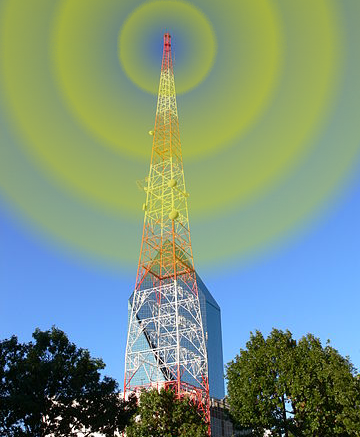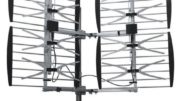You would thing this is a simple question, right? You’d be wrong. Over-the-air TV antennas have been with us for about 70 years now, and the answer to that question has changed several times. Not only that, but TV signals in the US use slightly different frequencies than their European or Asian counterparts. That’s important to know, because there aren’t too many antenna makers that actually design and build antennas in the USA. Let’s dive into this complex question with a little history.
For most of the 20th century…
…TV broadcasting could take place anywhere on Channels 2-83. Channel 1 had disappeared very early in the process, given over to first responders and other private communications. Because of the technology in use at the time, you needed at least one empty channel between any two broadcast channels, and a patchwork of different cities with different broadcasters meant that of the 82 available channels, most cities could use no more than about 20.
VHF and UHF
There are, of course, two distinct “bands” used for TV broadcasts. VHF channels 2-13 use 54-72MHz, 76-88MHz, and 174-216MHz. Channels 14-83, known as UHF, went from 470-890MHz. In between are all sorts of things like other private broadcasts, FM radio, and other forms of broadcasting. Above 890MHz, you have things like cordless phones and other consumer devices.
During the 20th century, VHF was king. All the major networks wanted to be on VHF to make it easy for people to find them. In large cities like New York and Chicago, they got their wish. In smaller cities like Detroit, some networks settled for UHF because it was what they could get.
So, if you bought an antenna in the 20th century, it was going to pick it all up: from 54-890MHz. For the most part you didn’t care if the antenna picked up other stuff, because it didn’t make a difference. The biggest culprit when it came to interference was FM radio, which is why many old antennas have a switchable FM trap.
1983: The really high channels go away
By the 1980s, it was pretty clear that TV broadcasting didn’t need as much space as it had. Not only that, channels 70-83 were really very sparsely used. The energy it takes to send a signal over those high channels is quite a bit more than sending it over low channels and remember TV broadcasting has to travel for 60-70 miles.
As a result, channels 70-83 were removed from TV broadcasting in 1983. However, for the most part antenna design didn’t change. The range from 806-890MHz is used for public safety agencies with relatively low power broadcasts. There wasn’t a real concern about interference with existing TV antennas.
In the meantime, channel 37 was given over to radio astronomy in a story that is surprisingly interesting.
Why antennas didn’t change
There are two things I really should bring up here. The first is that designing and testing a new antenna is a pretty expensive and big deal. The other is that as the frequency gets higher, the part of the antenna used to receive it gets smaller. So what you have is a situation where it doesn’t really save money to redesign an antenna, and it costs money to redesign it. Antenna designers are not, as a general rule, idiots, so they left antennas alone at that point.
2011: Even more frequencies go away
In 2009, the United States transitioned to digital broadcasting. It should come as no surprise that the transmitters made in the 21st century were a little more precise than those made in the 1950s. Because of this, the rules for “adjacent channels” were changed. This meant that if you wanted to have 40 broadcast channels in your market, you just had to make sure that none of them overlapped markets near you. At the same time, the rise of subchannels meant that as many as 10 different programs could share the same TV channel. In large markets like Los Angeles, this made it easy to have over 120 programs on at the same time.
At the same time, cell phone data use was exploding. The US government wisely took channels 52-69, from 698-806MHz, and reallocated them to things like cellular data.
During this transition, the industry as a whole had hoped that the use of VHF channels would go way down. Technologies like PSIP meant that the user could choose “channel 2” and actually get channel 36, and be none the wiser. Eliminating the use of VHF would make antennas much smaller and still as effective. Remember, the lower the frequency, the bigger the antenna.
Unfortunately, many broadcasters still stayed on their traditional spots on channels 2-13, meaning people in those cities still needed big antennas.
2020: One…. more… time!
By the mid-’10s, even the amount of frequency space allocated to cellular data a few years prior wasn’t enough. People wanted to stream, shop, and connect and they wanted fast transfers. This meant adding even more frequencies to the plan for cell phones. The logical place to take them was, once again, the set of TV stations.
Starting in 2014, the US government embarked on a “reverse auction” by which they offered to buy broadcast licenses from people who wanted to sell them. Not only would the broadcaster get cash, but if they wanted a different license, the government would subsidize the purchase of new equipment. It was a pretty good deal, all things considered.
After the smoke cleared, the government had managed to clear 84MHz of spectrum for use in cell phone data, and this was enough to move everyone’s broadcasts closer together. Channels 38-51, from 614-698MHz, were cleared and reallocated.
Remember that at this point broadcasting was precise enough that you didn’t need an empty “buffer” channel between (for example) channels 14 and 15. So, this plan offered 22 UHF channels as well as the traditional 12 VHF channels. More stations moved to VHF, but for the most part these were lower-power and non-network stations.
If you’re counting…
This means that depending on your broadcast market, you need one of three types of antennas:
- Full-spectrum antennas, like the Xtreme Signal HD8200XL, can receive channels 2-36, on 54-608MHz.
- UHF/VHF-High antennas, like the Televes Ellipse Mix, can receive channels 7-36, on 174-608MHz. These antennas are smaller and lighter and are a good choice for most folks.
- UHF-only antennas, like the Antop AT-403b, can receive channels 14-36, on 470-608MHz. These are often the most compact antennas on the market.
How do you know which one you need?
That’s the best part of this article. There’s a free service where a real technician will look at the details of your home or office and recommend the right antenna for you. It’s not just some app or automated service. These are real experts, and they’re here for you.
Just follow this link and fill out this form. Because this is a service staffed by real people, it sometimes takes a day or so. It’s worth waiting for, though, because you’ll get a list of everything you need to shop for, with links to the products at SolidSignal.com, and the email address of someone you can reach if you have questions or problems. How’s that for customer service?





